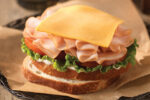Feeling stressed at the thought of having to cook pasta for a crowd right before your party starts? With a little planning and the right techniques, you can cook pasta ahead of time and keep it warm for your hungry guests. Whether you need a few pounds of linguine for a casual barbecue or want to serve penne alla vodka for a dinner party, these methods will help prevent your pasta from sticking together and losing its “al dente” texture while it waits. Simply cook the pasta to your desired doneness, drain and toss it with a little olive oil, then use a slow cooker, double boiler or chafing dish to keep it warm for up to two hours. Follow these simple steps to master the art of keeping pasta warm for your next party.
1. Double Boiler Method
The double boiler method is a gentle way to keep pasta warm for an extended period without overcooking it. It relies on indirect heat from simmering water to maintain the pasta’s temperature.
Start by bringing a pot of water to a boil on the stove. Cook the desired amount and type of pasta according to the instructions on the package. Drain the pasta, reserving about 1/2 cup of the pasta cooking water.
Transfer the cooked pasta to a heat-resistant bowl that will nestle comfortably inside your double boiler. The bowl should not touch the simmering water directly. Drizzle the pasta with a few tablespoons of olive oil and 1/4 cup of the reserved pasta water. The oil will coat the pasta and prevent it from sticking together while the water will help keep it moist.
Set the bowl over a pan of simmering water on the stove. The pan should be large enough that the bowl fits snugly within it without touching the water. The simmering water heats the bowl, which then gently warms the pasta from the sides and bottom.
Keep the water at a steady simmer, replenishing it as needed. Gently toss the pasta occasionally with tongs to coat it in the oil and water. Check the temperature of the pasta after about 15 minutes. If the pasta begins to dry out, add a little more of the reserved pasta water and olive oil. With frequent stirring, pasta kept in a double boiler can stay warm and moist for up to 2 hours. Just before serving, toss the pasta with any desired sauce and extras like vegetables or proteins.
2. Slow Cooker
Using a slow cooker is an easy and foolproof method for keeping pasta warm for a long period of time. The low, steady heat maintains the pasta’s temperature without drying it out.
To prepare the pasta, cook it according to the instructions on the package until al dente. Drain the pasta, reserving about 1 cup of the pasta cooking liquid.
Transfer the drained pasta to the slow cooker insert. Add enough olive oil to lightly coat the pasta, about 2 to 3 tablespoons. Pour in 1/2 cup of the reserved pasta cooking liquid and stir to combine. The oil and liquid will help keep the pasta from sticking together and drying out.
Cover the slow cooker and set it to the warm or low heat setting. If your slow cooker has a temperature control feature, select 180 to 200°F. Gently stir the pasta every 30 minutes or so to ensure even cooking and coating with the oil and liquid.
Check the pasta after about an hour. If it looks dry, stir in more of the reserved pasta liquid a few tablespoons at a time. Continue cooking, covered, stirring occasionally for up to 2 hours. Resist the urge to remove the lid too often, as this allows heat to escape.
Just before serving, stir in any desired extras like vegetables, meats or sauce. If the pasta has cooled and seems dry, heat it in the slow cooker on high for 5 to 10 minutes, adding a splash more oil and liquid as needed. Then stir in your additions and warm through. The slow cooker keeps the pasta beautifully “al dente” and moist, ready to be enjoyed straight from the cooker or transferred to a serving dish.
3. Chafing Dish
A chafing dish is a versatile piece of catering equipment that can also keep pasta warm for several hours. The steady heat from the fuel tabs underneath keeps the pasta at an ideal temperature without overcooking it.
To prepare the pasta, cook it according to the package directions until al dente. Drain the pasta, reserving the cooking liquid.
Transfer the drained pasta to the chafing dish insert. Drizzle it with 2 to 3 tablespoons of olive oil and sprinkle with a pinch of salt. Toss gently to evenly coat the pasta.
Pour enough of the reserved pasta cooking liquid into the dish to just coat the pasta. The liquid should come about halfway up the sides of the noodles but not pool at the bottom. Too much liquid can make the pasta soggy.
Place the chafing dish insert onto the base and snap on the lid. Position the fuel tabs under the pan and light them as directed. You may need to adjust the position of the tabs to evenly distribute heat across the bottom of the pan.
Gently toss and stir the pasta occasionally with tongs as it heats. The indirect heat from the fuel tabs will gradually warm the pan and its contents. Check the pasta after 15 to 20 minutes; if it looks dry, add a splash more reserved liquid.
When the pasta is heated through and coated to your liking, turn off the heat tabs, remove the lid and add any desired extras like vegetables, meats or sauce. Toss gently to coat the pasta and evenly distribute the other ingredients. Re-cover the dish with the lid and allow the extra ingredients to heat through. The chafing dish will keep the now “complete” pasta dish warm for at least an hour. Just before serving, fluff the pasta again with a fork and transfer to a warmed serving platter.
4. Oven Method
The oven is an easy way to keep large amounts of pasta warm for a party, though it can dry out the pasta if not done properly.
- Preheat the oven to 225°F.
- Use an oven-safe dish large enough to hold all your pasta in a single layer. Glass or ceramic dishes work best.
- After cooking the pasta according to the package directions, drain it and transfer it to the dish.
- Toss the pasta with 2 to 3 tablespoons of olive oil or butter to coat. The fat will help prevent the pasta from sticking and absorbing too much heat.
- Optionally, you can also mix the pasta with a small amount of sauce at this stage.
- Cover the dish tightly with aluminum foil. The foil will help trap steam and moisture, keeping the pasta from drying out.
- Place the covered dish in the oven and bake for 30 minutes.
- Remove the dish and gently stir the pasta, flipping the pieces over. Re-cover and return to the oven for another 15 to 30 minutes.
- Check the pasta after 15 minutes. If it is still moist and coated with the oil or sauce, you can leave it in the oven for up to 1 hour total.
- Stir the pasta 2 to 3 times during baking to ensure even heating and coating.
- If the pasta starts to look dry, brush or stir in an additional 1 to 2 tablespoons of oil or melted butter.
- Remove the foil and stir in any remaining sauce or mix-ins. The pasta is now ready to serve straight from the oven or transferred to a warming dish.
Tips for Keeping Pasta Warm
Follow these general tips to ensure your kept-warm pasta stays tasty, not nasty:
- Cook the pasta al dente, slightly underdone. Pasta will continue to cook as it sits, so leaving it a touch firm at first will yield better results.
- Drain the pasta well, but reserve about 1 cup of the cooking water. You’ll need this starchy liquid to coat and moisten the pasta as it waits.
- Toss the hot pasta immediately with olive oil or melted butter. Approximately 2 to 3 tablespoons per pound of pasta will sufficiently coat it without making it greasy.
- Stir in a portion of the reserved pasta water. Start with 1/4 to 1/2 cup and add more gradually as needed to keep the pasta moist without creating excess liquid in the dish or container.
- Mix any desired ingredients like sauce, vegetables or meat into the pasta right before serving time, not in advance. This ensures the extras heat through at the same rate as the pasta itself.
- Gently toss and stir the pasta every 15 to 30 minutes while it waits. This helps redistribute moisture, coats the noodles and prevents sticking.
- Check the pasta’s temperature after 30 minutes and frequently thereafter. If it begins to cool, return it to the oven or stove briefly to reheat.
- Continue adding oil or butter and small amounts of pasta water as needed to keep the pasta moist and well-coated. Signs it’s becoming dry are noodles sticking together, a starchy smell and the pasta losing its glossy finish.
- Serve the kept-warm pasta within 1 to 2 hours for best results. After that the texture starts degrading noticeably and bacteria growth becomes a concern.
By following these tried-and-true techniques for keeping pasta warm using a slow cooker, double boiler, chafing dish or oven, you can prevent your carefully cooked pasta from drying out or becoming gummy while your party gets underway. Be sure to frequently stir the pasta and add extra oil or butter as needed to keep it perfectly “al dente” right up to the moment you’re ready to enjoy it with your guests.
FAQs
1. How long does pasta stay warm?
Properly prepared pasta can typically stay warm and edible for 1 to 2 hours using effective methods like a slow cooker or chafing dish.
2. Why does my kept-warm pasta stick?
Pasta that sticks together when kept warm is often due to insufficient oil or butter. Make sure to thoroughly coat the hot pasta with 2 to 3 tablespoons of oil per pound after draining.
3. Can leftover pasta be reheated?
Yes! Leftover pasta can be reheated in a covered pan on the stove over low heat, adding a tablespoon or two of water. For crispier reheated pasta, place it in a greased skillet and cook until browned.




